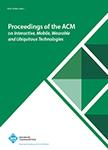版权所有:内蒙古大学图书馆 技术提供:维普资讯• 智图
内蒙古自治区呼和浩特市赛罕区大学西街235号 邮编: 010021

作者机构:Department of Computer Science and Technology University of Cambridge Cambridge United Kingdom Alan Turing Institute London United Kingdom Department of Computer Science and Technology University of Cambridge Cambridge United Kingdom Mrc Epidemiology Unit School of Clinical Medicine University of Cambridge Cambridge United Kingdom
出 版 物:《Proceedings of the ACM on Interactive, Mobile, Wearable and Ubiquitous Technologies》 (Proc. ACM Interact. Mob. Wearable Ubiquitous Technol.)
年 卷 期:2021年第5卷第1期
页 面:1-30页
核心收录:
基 金:This work is partially supported by Nokia Bell Labs through their donation for the Centre of Mobile Wearable Systems and Augmented Intelligence to the University of Cambridge. CI.T is additionally supported by the Doris Zimmern HKU-Cambridge Hughes Hall Scholarship and from the Higher Education Fund of the Government of Macao SAR China. D.S is supported by the Embiricos Trust Scholarship of Jesus College Cambridge and EPSRC through Grant DTP (EP/N509620/1). I.P is supported by GlaxoSmithKline and EPSRC through an iCase fellowship (17100053). The authors declare that they have no conflict of interest with respect to the publication of this work
摘 要:Machine learning and deep learning have shown great promise in mobile sensing applications, including Human Activity Recognition. However, the performance of such models in real-world settings largely depends on the availability of large datasets that captures diverse behaviors. Recently, studies in computer vision and natural language processing have shown that leveraging massive amounts of unlabeled data enables performance on par with state-of-the-art supervised models. In this work, we present SelfHAR, a semi-supervised model that effectively learns to leverage unlabeled mobile sensing datasets to complement small labeled datasets. Our approach combines teacher-student self-training, which distills the knowledge of unlabeled and labeled datasets while allowing for data augmentation, and multi-task self-supervision, which learns robust signal-level representations by predicting distorted versions of the input. We evaluated SelfHAR on various HAR datasets and showed state-of-the-art performance over supervised and previous semi-supervised approaches, with up to 12% increase in F1 score using the same number of model parameters at inference. Furthermore, SelfHAR is data-efficient, reaching similar performance using up to 10 times less labeled data compared to supervised approaches. Our work not only achieves state-of-the-art performance in a diverse set of HAR datasets, but also sheds light on how pre-training tasks may affect downstream performance. © 2021 Owner/Author.